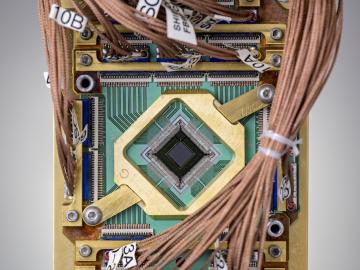
Filter News
Area of Research
- (-) Advanced Manufacturing (6)
- (-) Supercomputing (91)
- Biological Systems (1)
- Biology and Environment (41)
- Computational Biology (2)
- Computational Engineering (2)
- Computer Science (12)
- Electricity and Smart Grid (3)
- Energy Science (157)
- Energy Sciences (1)
- Functional Materials for Energy (2)
- Fusion and Fission (11)
- Fusion Energy (2)
- Isotope Development and Production (1)
- Isotopes (9)
- Materials (115)
- Materials Characterization (1)
- Materials for Computing (18)
- Materials Under Extremes (1)
- National Security (24)
- Neutron Science (53)
- Nuclear Science and Technology (9)
- Quantum information Science (9)
- Sensors and Controls (1)
- Transportation Systems (2)
News Topics
- (-) Artificial Intelligence (38)
- (-) Biomedical (17)
- (-) Energy Storage (8)
- (-) Grid (5)
- (-) Materials Science (21)
- (-) Molten Salt (1)
- (-) Quantum Science (25)
- (-) Transportation (6)
- 3-D Printing/Advanced Manufacturing (25)
- Advanced Reactors (2)
- Big Data (22)
- Bioenergy (9)
- Biology (11)
- Biotechnology (2)
- Buildings (4)
- Chemical Sciences (5)
- Composites (3)
- Computer Science (96)
- Coronavirus (14)
- Critical Materials (3)
- Cybersecurity (8)
- Environment (22)
- Exascale Computing (26)
- Frontier (32)
- Fusion (2)
- High-Performance Computing (43)
- Isotopes (2)
- Machine Learning (16)
- Materials (21)
- Mathematics (2)
- Microscopy (7)
- Nanotechnology (11)
- National Security (8)
- Neutron Science (15)
- Nuclear Energy (5)
- Partnerships (1)
- Physics (8)
- Polymers (2)
- Quantum Computing (20)
- Security (6)
- Simulation (16)
- Software (1)
- Space Exploration (4)
- Summit (43)
Media Contacts

To better understand the spread of SARS-CoV-2, the virus that causes COVID-19, Oak Ridge National Laboratory researchers have harnessed the power of supercomputers to accurately model the spike protein that binds the novel coronavirus to a human cell receptor.

Oak Ridge National Laboratory researchers have demonstrated that a new class of superalloys made of cobalt and nickel remains crack-free and defect-resistant in extreme heat, making them conducive for use in metal-based 3D printing applications.

A multi-institutional team became the first to generate accurate results from materials science simulations on a quantum computer that can be verified with neutron scattering experiments and other practical techniques.

In the quest for advanced vehicles with higher energy efficiency and ultra-low emissions, ORNL researchers are accelerating a research engine that gives scientists and engineers an unprecedented view inside the atomic-level workings of combustion engines in real time.

Six scientists at the Department of Energy’s Oak Ridge National Laboratory were named Battelle Distinguished Inventors, in recognition of obtaining 14 or more patents during their careers at the lab.

Six ORNL scientists have been elected as fellows to the American Association for the Advancement of Science, or AAAS.

A multi-institutional team, led by a group of investigators at Oak Ridge National Laboratory, has been studying various SARS-CoV-2 protein targets, including the virus’s main protease. The feat has earned the team a finalist nomination for the Association of Computing Machinery, or ACM, Gordon Bell Special Prize for High Performance Computing-Based COVID-19 Research.

ORNL and three partnering institutions have received $4.2 million over three years to apply artificial intelligence to the advancement of complex systems in which human decision making could be enhanced via technology.

Scientists from Oak Ridge National Laboratory used high-performance computing to create protein models that helped reveal how the outer membrane is tethered to the cell membrane in certain bacteria.

Kübra Yeter-Aydeniz, a postdoctoral researcher, was recently named the Turkish Women in Science group’s “Scientist of the Week.”


